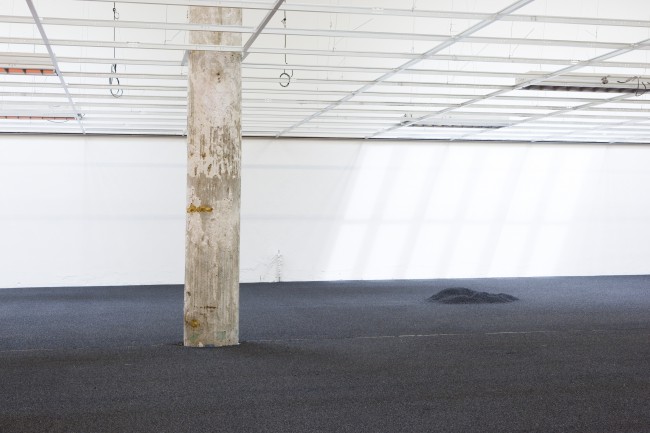It’s Only Rock ’n Roll (But We Like It)
Jochen SchmithA work for the floor of W139 by the artist collective Jochen Schmith.




Jochen Schmith is an artist’s collective, founded in Hamburg in 2000. Lives and works in Brussels, Hamburg and Berlin.
Peter Steckroth (1966, Marseille)
Peter Hoppe (1978, Kaapstad)
Carola Wagenplast (1981, Brussels)
June 2011 - Tim Voss, director W139:
Since exactly one year I am holding the artistic direction of W139. I approached the artist collective Jochen Schmith — my former fellow students Carola Wagenplast, Peter Hoppe and Peter Steckroth — to look into the perception of W139’s history as well as the architectural conditions in relation to my ideas of the programme. Jochen Schmith suggested a work for the floor and a light installation; both are intended for permanent use. Now they realised the first part.
For the floor work It’s Only Rock ’n Roll (But We Like It), Jochen Schmith installed a floor of asphalt mixed with granulated steel slag (black shimmer) and crystallite. In reference to, and simultaneously in contrast to, the Amsterdam-based artist Ahmet Ögüt (who in 2007 installed four hundred square metres of raw asphalt in Kunst-Werke Berlin[1]), Jochen Schmith’s work transforms the controlled moment of the material and its habitus. The connotation of the asphalt as a material of public space is cited as a potential for the exhibition and event establishment of W139.
Asphalt in galleries, normally polished and sealed, is no rarity anymore. W139 is an art space for production and presentation. Therefore the floor is not retained as an artefact but conceptually applied by Jochen Schmith and released for its appropriate use. What at first sight comes across like a newly bought, well designed, but awkwardly fitting pair of sneakers, will obtain and show W139’s correlating patina over the years ahead.
According to the work that Jochen Schmith created for W139, as well as to my aspirations for the form of the programme, the artistic intervention implies that the experience of exhibitions is not just reduced to looking at objects, but works for an overall exchange of art and life: an indoor marketplace for the exchange of ideas and their forms.
[1] Ground Control, fifth Berlin Biennial, 2007: “In Turkey, the laying of asphalt was a means of homogenizing the country in its rapid quest to modernize, metaphorically covering over some of its diverse history in the process […] to bring them under government control, purportedly to improve security.”
Photo's: Idan Shilon